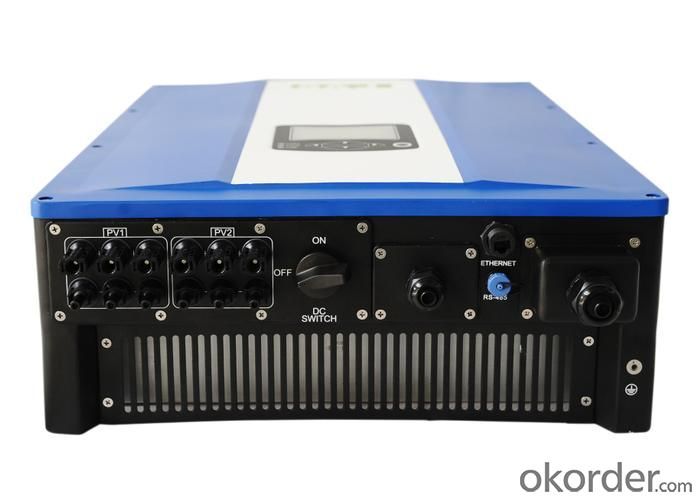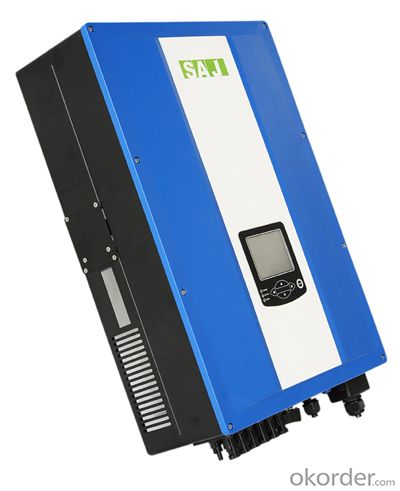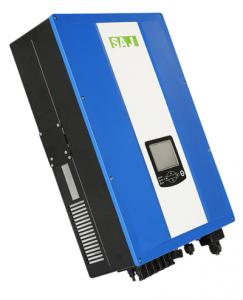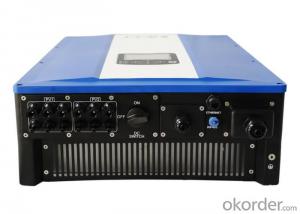On gird solar inverter Suntrio-TL17K WITH 2 MPPT
- Loading Port:
- Guangzhou
- Payment Terms:
- TT OR LC
- Min Order Qty:
- 1 watt
- Supply Capability:
- 3000 watt/month
OKorder Service Pledge
OKorder Financial Service
You Might Also Like
Suntrio-TL12K/15K/17K/20K PV inverters are transformerless inverters with efficiency of up to 98.1%. Multi-MPPT inputs provides higher flexibility for the project installation. Stainless steel housing and IP65 protection guarantee use both indoor and outdoor for long. The series inverters are ideally suited for medium and commercial PV projects of up to MW range.
1. Leading technology
· Max. efficiency 98.1%
• MPPT accuracy up to 99.9% efficiency
• Compliant with VDE-AR-N 4105
2. User-friendly
• 5 inch LCD display with comprehensive information
• Embedded webserver monitoring
• Easy installation
3. Flexible
• Multi-country configuration
• RS485 / Ethernet / Wi-Fi communication
• Wide range of DC input voltage
• IP65 for indoor and outdoor
4. Certificates: TUV,SAA,G83,ISO9001,ISO14001,etc.
Futures
■ Two independent MPPT for flexible configuration.
■ Space Vector PWM to maximize efficiency and minimize EMI.
■ Highest MPPT performance, up to 99.9% efficiency.
■ Transformerless design with 98.1% Max. efficiency.
■ Ethernet/ Wi-Fi communication interface.
■ Integrated Web Server for overall performance monitoring.
■ Compliance with VDE-AR-N 4105 with reactive power control.
■ 5-inch large LCD display.
■ LCD day/month/year/total yield graphs display.
■ Event history lookup
■ Easy operation with 5 navigation buttons.


1. How long will my inquiry get response?
Your inquiry related to our products or prices will be replied within 24 hours.
2. Can I get professional service and suggestion?
Well-trained and experienced staffs to answer all your questions in fluent English.
3. Do you accept OEM or customized design?
OEM & ODM, any your customized lightings we can help you to design and put into product.
4. What if I need specific design?
Distributorship are offered for your unique design and some our current models.
- Q:Can a solar inverter be used for off-grid systems?
- Yes, a solar inverter can be used for off-grid systems. In fact, it is an essential component of off-grid solar systems as it converts the DC power generated by solar panels into AC power that can be used to run appliances and devices. The solar inverter also manages the charging and discharging of batteries in off-grid systems, ensuring a stable and reliable power supply even when the sun is not shining.
- Q:What is the role of a solar inverter in preventing islanding?
- The role of a solar inverter in preventing islanding is to continuously monitor the electrical grid and quickly disconnect from it if it detects any abnormalities or disruptions. This prevents the solar inverter from operating in an isolated or "islanded" mode, which could pose safety risks to utility workers and damage electrical equipment. By promptly disconnecting from the grid during such events, the solar inverter helps maintain the stability and integrity of the overall electrical system.
- Q:How does a solar inverter handle variations in AC load demand?
- A solar inverter handles variations in AC load demand by continuously monitoring the load demand and adjusting the amount of power it delivers from the solar panels accordingly. This is achieved through advanced control algorithms that optimize the conversion of DC power generated from the solar panels into AC power that matches the load demand. The inverter maintains a stable voltage and frequency output, ensuring that the electrical devices connected to it receive a consistent and reliable power supply, even when there are fluctuations in the AC load demand.
- Q:What is the role of a display or user interface in a solar inverter?
- The role of a display or user interface in a solar inverter is to provide users with real-time information about the performance, status, and operational parameters of the inverter system. It allows users to monitor the energy production, voltage levels, current flow, and any potential faults or errors. Additionally, the user interface enables users to configure and control various settings of the solar inverter, such as output power limits, grid synchronization, and system diagnostics.
- Q:What is the role of a solar inverter in a utility-scale system?
- The role of a solar inverter in a utility-scale system is to convert the direct current (DC) electricity produced by the solar panels into alternating current (AC) electricity that can be fed into the utility grid. It also ensures the maximum power output of the solar panels by tracking the maximum power point. Additionally, the inverter provides grid synchronization and protection functions to ensure the safe and efficient operation of the utility-scale solar system.
- Q:Can a solar inverter be used in harsh environmental conditions?
- Yes, solar inverters are designed to withstand harsh environmental conditions such as extreme temperatures, high humidity, and exposure to dust, dirt, and corrosive elements. They are built with robust materials and undergo rigorous testing to ensure their durability and reliability in challenging environments. Additionally, some solar inverters come with IP65 or higher ratings, indicating their resistance to water and dust ingress, making them suitable for installation in outdoor and harsh conditions.
- Q:What is the maximum number of solar panels that a solar inverter can support?
- The maximum number of solar panels that a solar inverter can support depends on the specific model and its capacity. However, most solar inverters are designed to support a certain capacity or power rating, rather than a specific number of panels. The capacity of the solar inverter, measured in kilowatts (kW) or megawatts (MW), determines the maximum power output it can handle. The number of panels that can be connected to the inverter depends on the power rating of each panel. So, it is best to consult the manufacturer's specifications or seek professional advice to determine the maximum number of panels that can be supported by a specific solar inverter.
- Q:Can a solar inverter be used with solar-powered greenhouse systems?
- Yes, a solar inverter can be used with solar-powered greenhouse systems. A solar inverter is responsible for converting the DC power produced by solar panels into AC power that can be used to run electrical devices. In the context of a solar-powered greenhouse system, the solar inverter would be essential for converting the solar energy collected by the panels into usable electricity to power various components such as fans, pumps, lighting, and climate control systems within the greenhouse.
- Q:What is the role of a power limiter in a solar inverter system?
- The primary function of a power limiter in a solar inverter system is to regulate the amount of power that is supplied to the grid from the solar panels. When the solar panels produce more power than necessary or permitted by the grid, the power limiter serves as a control mechanism to restrict the amount of power injected into the grid. This control mechanism ensures that the power output from the solar panels remains within the specified limits, preventing any overloading or destabilization of the grid. To achieve this, the power limiter continuously monitors the power output from the solar panels and adjusts it accordingly to meet the grid requirements. It achieves this by intelligently controlling the inverter, which converts the direct current (DC) generated by the solar panels into alternating current (AC) suitable for integration with the grid. By limiting the power fed into the grid, the power limiter plays a crucial role in maintaining the stability of the grid. It helps prevent voltage fluctuations, reduces the risk of power surges or blackouts, and ensures compliance with local regulations and grid codes pertaining to solar power generation. Furthermore, the power limiter can offer additional functionalities such as grid synchronization, anti-islanding protection, and remote monitoring. These additional features enhance the safety, reliability, and overall performance of the solar inverter system. In summary, the inclusion of a power limiter in a solar inverter system is essential for maintaining a balance between power generation and grid stability. It optimizes the use of solar energy and ensures the safe and efficient integration of solar power into the electrical grid.
- Q:Can a solar inverter be used with a solar-powered vehicle?
- Yes, a solar inverter can be used with a solar-powered vehicle. A solar inverter is used to convert the direct current (DC) produced by solar panels into alternating current (AC) that can be used to power various electrical components of a vehicle. In a solar-powered vehicle, the solar panels generate DC electricity, which is then converted by the solar inverter into AC electricity to charge the vehicle's battery or power its electrical systems.
1. Manufacturer Overview |
|
|---|---|
| Location | |
| Year Established | |
| Annual Output Value | |
| Main Markets | |
| Company Certifications | |
2. Manufacturer Certificates |
|
|---|---|
| a) Certification Name | |
| Range | |
| Reference | |
| Validity Period | |
3. Manufacturer Capability |
|
|---|---|
| a)Trade Capacity | |
| Nearest Port | |
| Export Percentage | |
| No.of Employees in Trade Department | |
| Language Spoken: | |
| b)Factory Information | |
| Factory Size: | |
| No. of Production Lines | |
| Contract Manufacturing | |
| Product Price Range | |
Send your message to us
On gird solar inverter Suntrio-TL17K WITH 2 MPPT
- Loading Port:
- Guangzhou
- Payment Terms:
- TT OR LC
- Min Order Qty:
- 1 watt
- Supply Capability:
- 3000 watt/month
OKorder Service Pledge
OKorder Financial Service
Similar products
New products
Hot products
Hot Searches
Related keywords






























